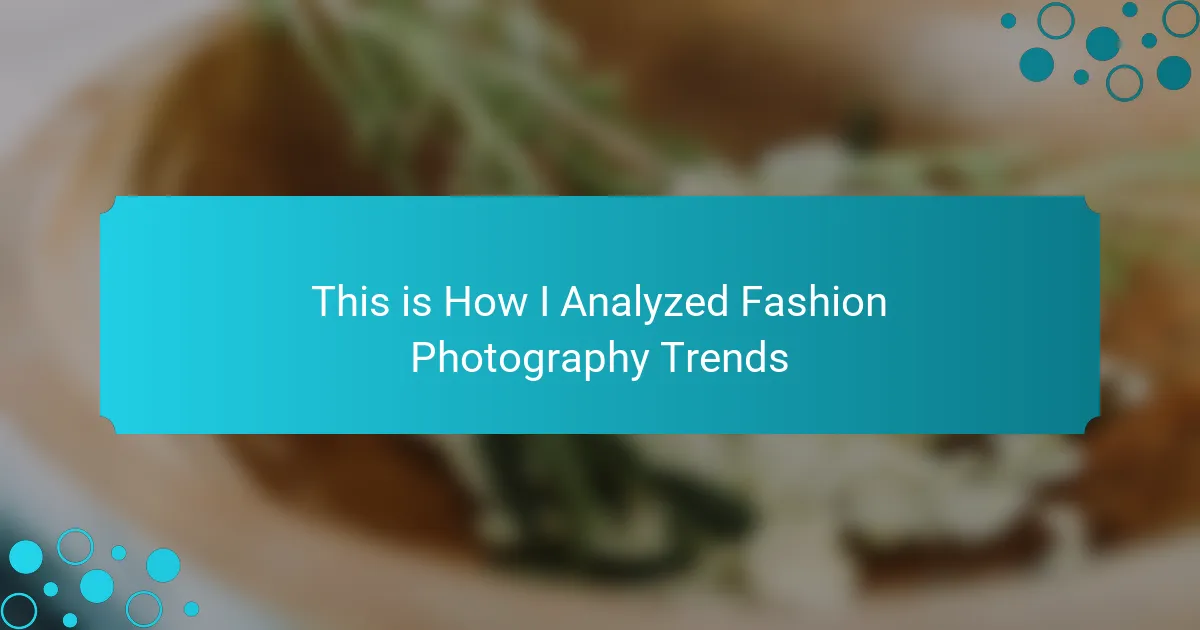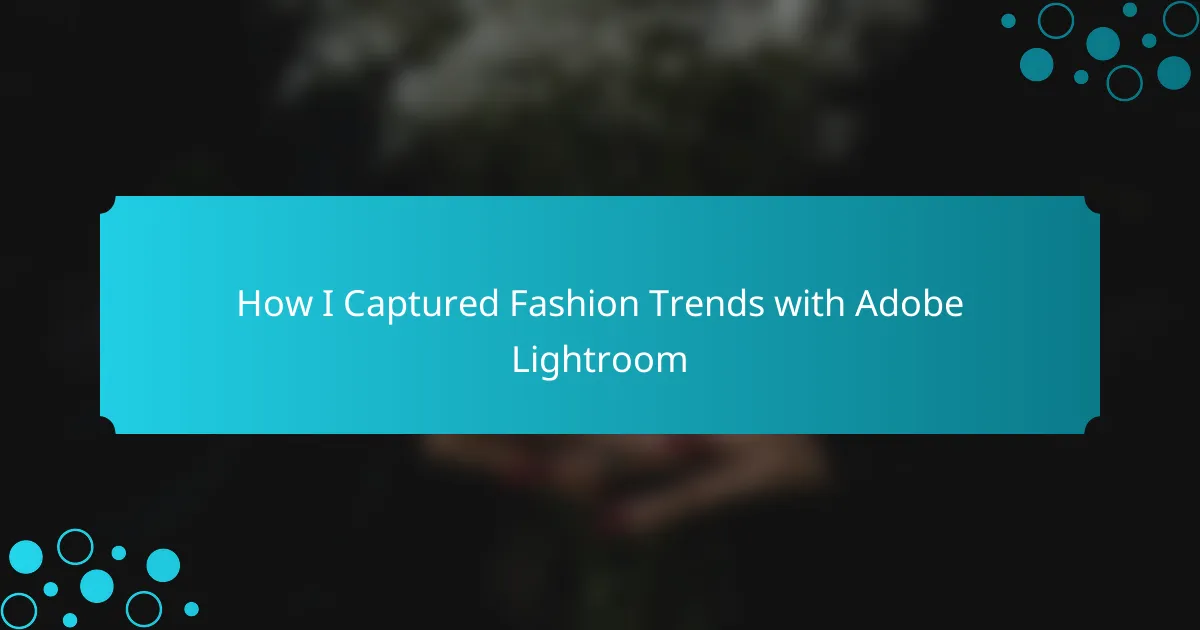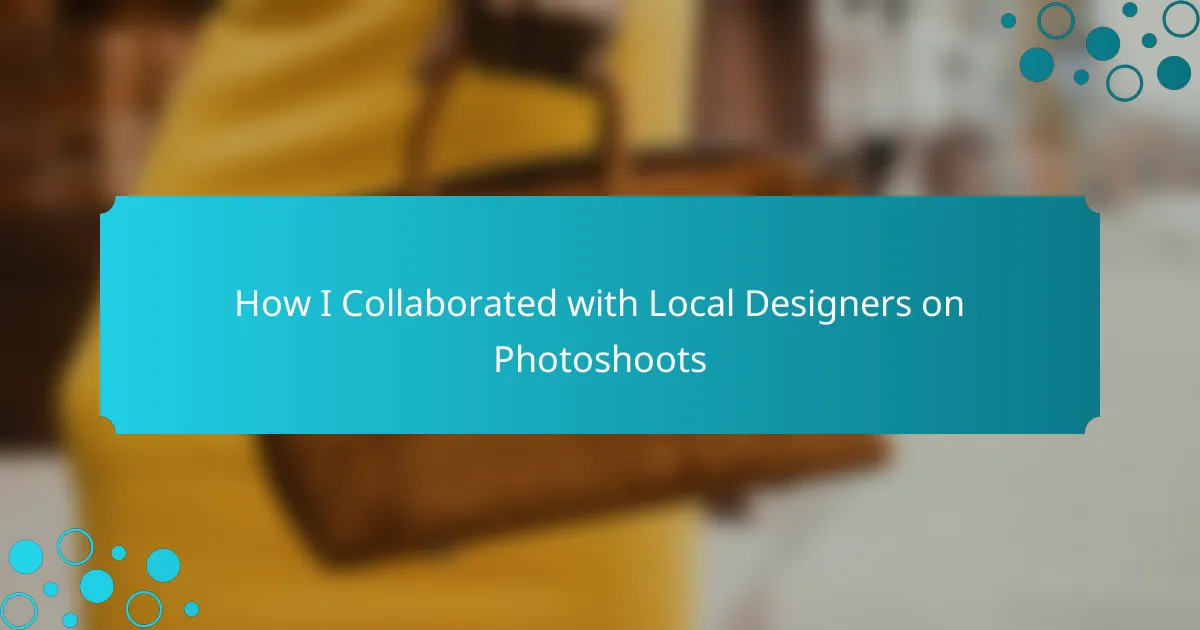Key takeaways
- Editorial photography emphasizes storytelling and emotion, capturing concepts and moods rather than merely showcasing products.
- It is crucial in the fashion industry for establishing trends, communicating brand narratives, and reflecting cultural movements.
- Popular styles include high fashion, lifestyle, and conceptual photography, each bringing unique storytelling elements to the forefront.
- Aspiring photographers should focus on developing a unique voice, staying authentic, and networking for fresh ideas and perspectives.
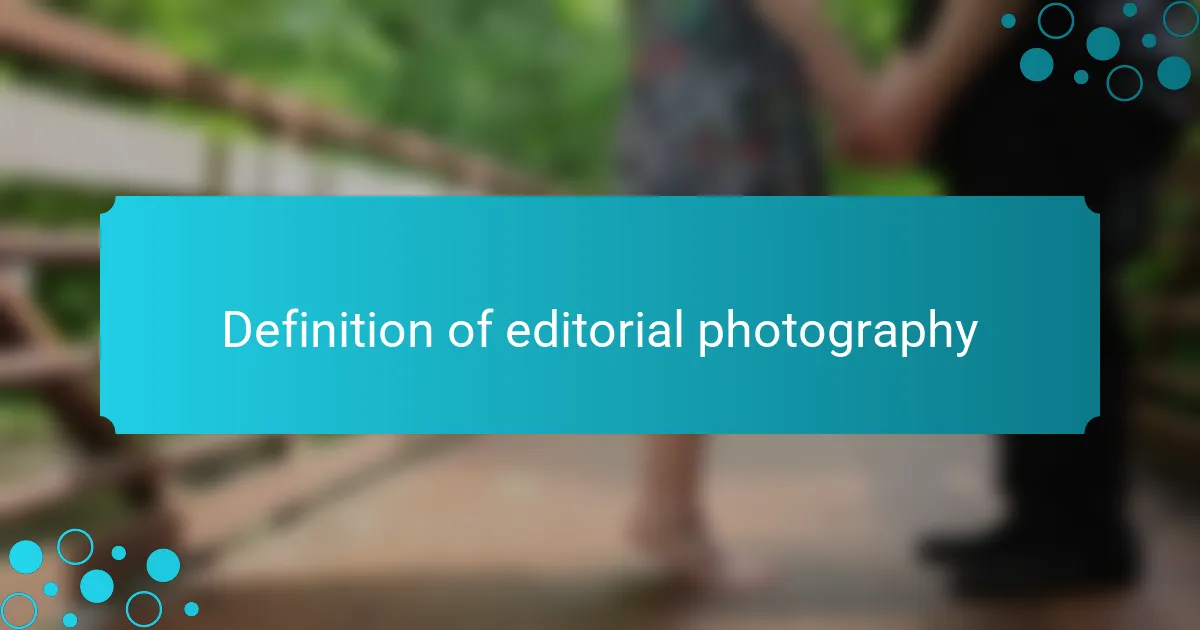
Definition of editorial photography
Editorial photography is a distinct genre that prioritizes storytelling through images, often used in magazines and advertising campaigns. It goes beyond just showcasing products; it captures a mood, an atmosphere, or a concept that resonates with viewers. I remember flipping through a high-fashion magazine and being moved by a series of images that told a complete story, making me feel the emotion behind the fashion.
In my experience with editorial shoots, I’ve seen firsthand how each photograph can evoke feelings and provoke thoughts. The lighting, styling, and composition all work together to create a cohesive narrative. Here are some key characteristics of editorial photography:
- Focuses on storytelling and concept rather than just the subject.
- Utilizes creative settings and unique styling to enhance visual interest.
- Often features bold and artistic elements, pushing the boundaries of traditional photography.
- Aims to evoke emotions, sparking connections with the audience.
- Typically appears in magazines, online publications, and advertising to convey a message or theme.
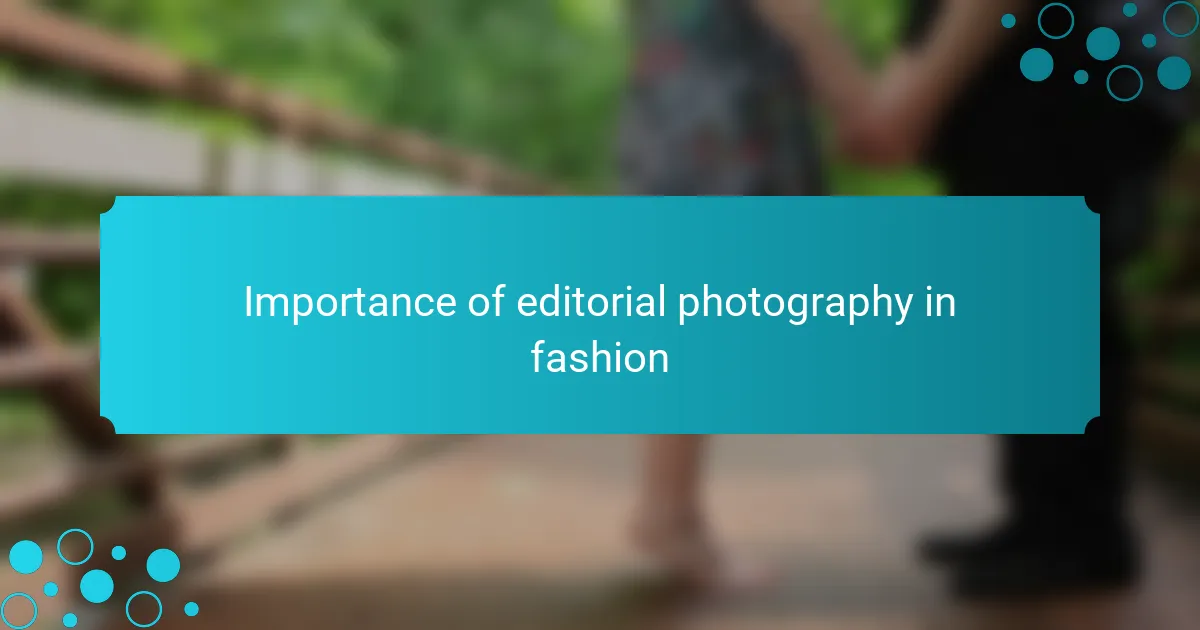
Importance of editorial photography in fashion
When I think about the importance of editorial photography in fashion, I can’t help but recall my own experiences at photo shoots. Those moments, with vibrant colors and striking poses, serve as a visual narrative that goes beyond just clothing. Editorial photography captures the essence of a collection, allowing designers to convey their artistic vision and evoke emotions that resonate with the audience.
In addition to storytelling, editorial photography plays a crucial role in establishing trends. It showcases style in a way that ignites inspiration, inviting viewers to engage with fashion on a deeper level. Here are some key points highlighting the importance of editorial photography in the fashion industry:
- Visual Storytelling: It communicates a brand’s narrative, giving context to the fashion pieces and making them relatable.
- Trend Setting: Editorial shoots introduce and popularize new looks, influencing consumer choices and shaping the market.
- Creativity Showcase: It provides a platform for photographers and stylists to experiment with innovative concepts and techniques.
- Brand Identity: Helps solidify a designer’s or brand’s identity through distinctive visual styles that resonate with their target audience.
- Cultural Reflection: Offers a mirror to societal trends and cultural movements, allowing fashion to remain relevant and impactful.
These aspects underline how editorial photography is not just about visuals; it’s about connecting art, fashion, and feelings in a powerful way.
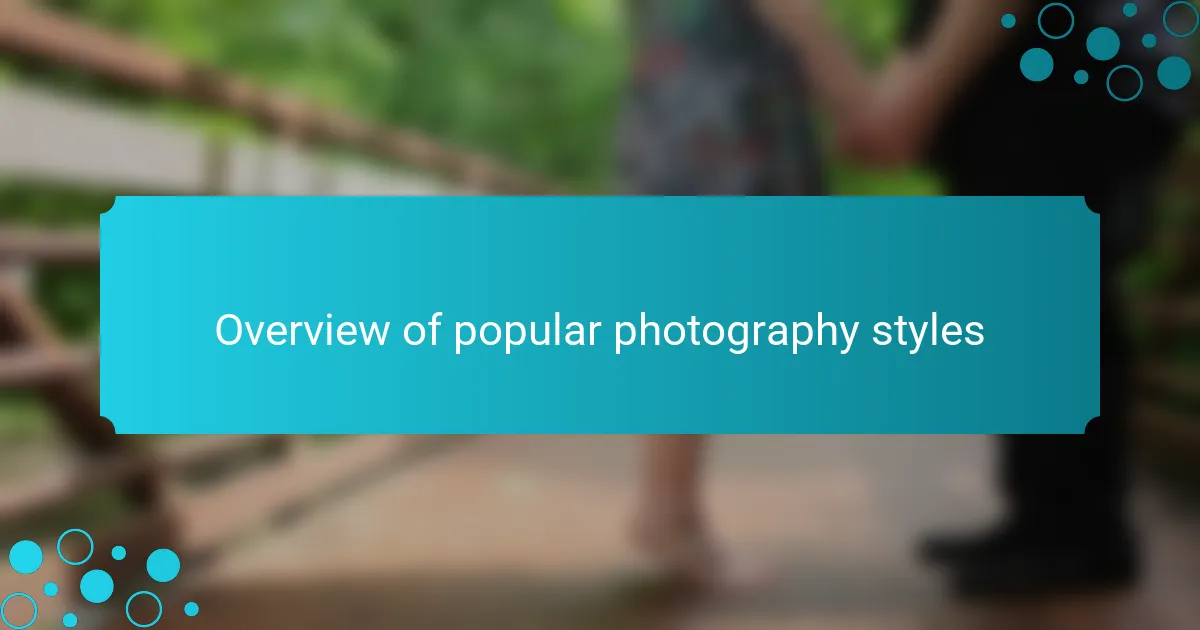
Overview of popular photography styles
When exploring popular photography styles, I’ve noticed how each one brings a unique essence to editorial work. From high fashion to lifestyle, different styles evoke varying emotions and tell diverse stories about beauty and fashion. I’ve found that knowing these styles helps in choosing the right approach for a specific project.
Some prominent editorial photography styles include:
- High Fashion: This style focuses on dramatic visuals, pushing boundaries in both clothing design and photography techniques, often using elaborate sets.
- Commercial: Aimed at marketing products, commercial photography typically emphasizes clarity and appeal while keeping the focus on the item being showcased.
- Candid: Capturing genuine moments, candid photography often showcases true emotions and interactions, making it relatable and engaging.
- Minimalist: This style utilizes simplicity to highlight the beauty of the subject and the clothing, stripping away distractions for a clean, sophisticated look.
- Conceptual: Featuring inventive ideas and visuals, conceptual photography provides a narrative element that allows for artistic expression and new perspectives in fashion.
I remember my first encounter with high fashion photography; the strong visuals left me exhilarated yet inspired. Each frame felt like a piece of art, imbued with a story waiting to be told.
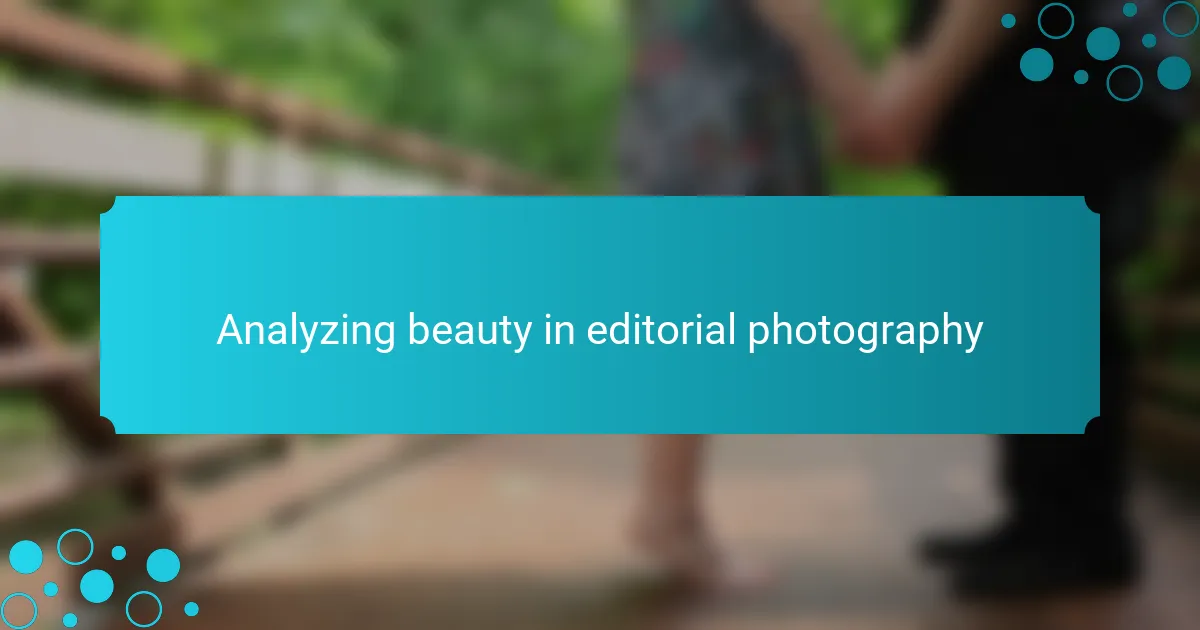
Analyzing beauty in editorial photography
When I reflect on beauty in editorial photography, I often think about how it captures more than just aesthetics; it conveys a narrative. Each shot tells a story, evoking emotions through expressions, poses, and settings. I remember one shoot where the model’s gaze directly connected with the camera, making me feel as though I was part of a broader narrative, not just an observer.
Beauty in editorial photography can be identified through several key aspects:
- Emotion: Powerful images evoke feelings and resonate with viewers.
- Composition: A well-structured layout enhances the overall impact.
- Lighting: Natural or dramatic lighting can transform a mundane scene into something magical.
- Styling: Fashion choices play a crucial role in defining the mood and message.
- Cultural Reflection: It often reflects societal standards of beauty and challenges them.
- Innovative Concepts: Unique themes push the boundaries of traditional beauty norms.
These elements, when combined, create compelling imagery that inspires and captivates.
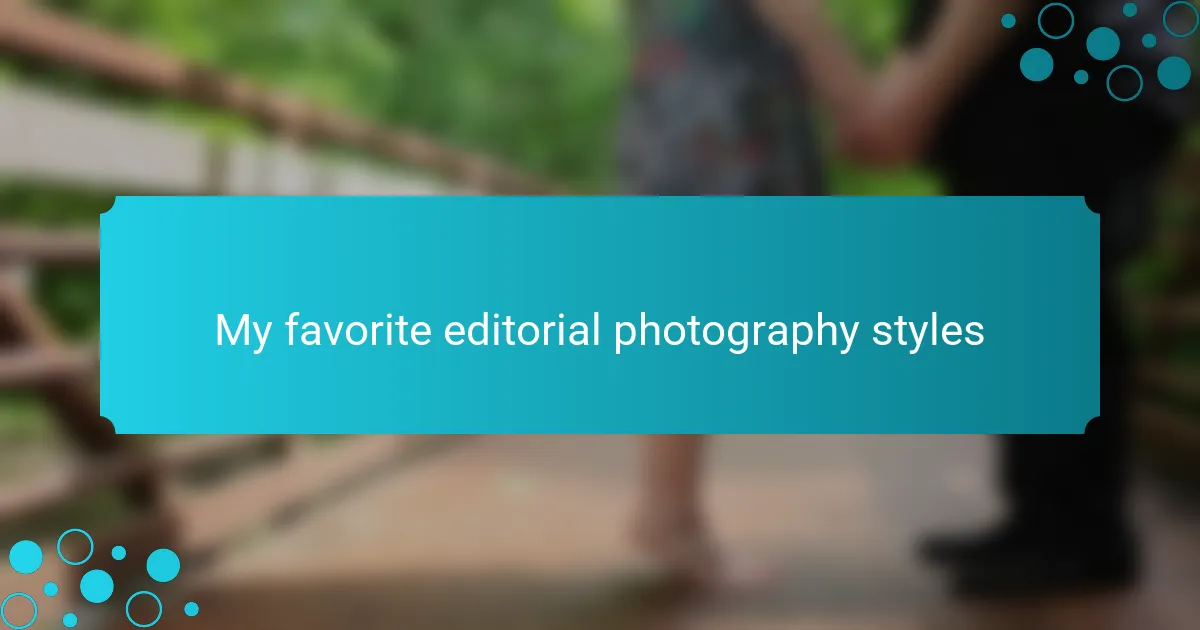
My favorite editorial photography styles
When it comes to editorial photography styles, I have a few favorites that really speak to me. One style I adore is high fashion, with its bold colors and avant-garde concepts. I remember a shoot where the combination of dramatic lighting and fierce poses brought an incredible energy to the images, making the fashion the undeniable star. Then there’s lifestyle photography, which captures the essence of everyday life while still showcasing stunning outfits. I find it refreshing, as it allows for a more relatable connection to the audience.
Another style that resonates with me is conceptual photography. It’s fascinating how a well-thought-out theme can transform a simple outfit into a statement piece. In one project, we collaborated on a story that revolved around dreams, and the resulting imagery felt both surreal and deeply personal. Each style offers something unique, and together they create a rich tapestry of visual storytelling in the fashion world.
| Photography Style | Description |
|---|---|
| High Fashion | Bold, dramatic, and often avant-garde, focusing on unique designs and artistry. |
| Lifestyle | Captures real-life moments while showcasing stylish outfits in relatable settings. |
| Conceptual | Tells a story or explores a theme, highlighting creativity and emotional depth. |
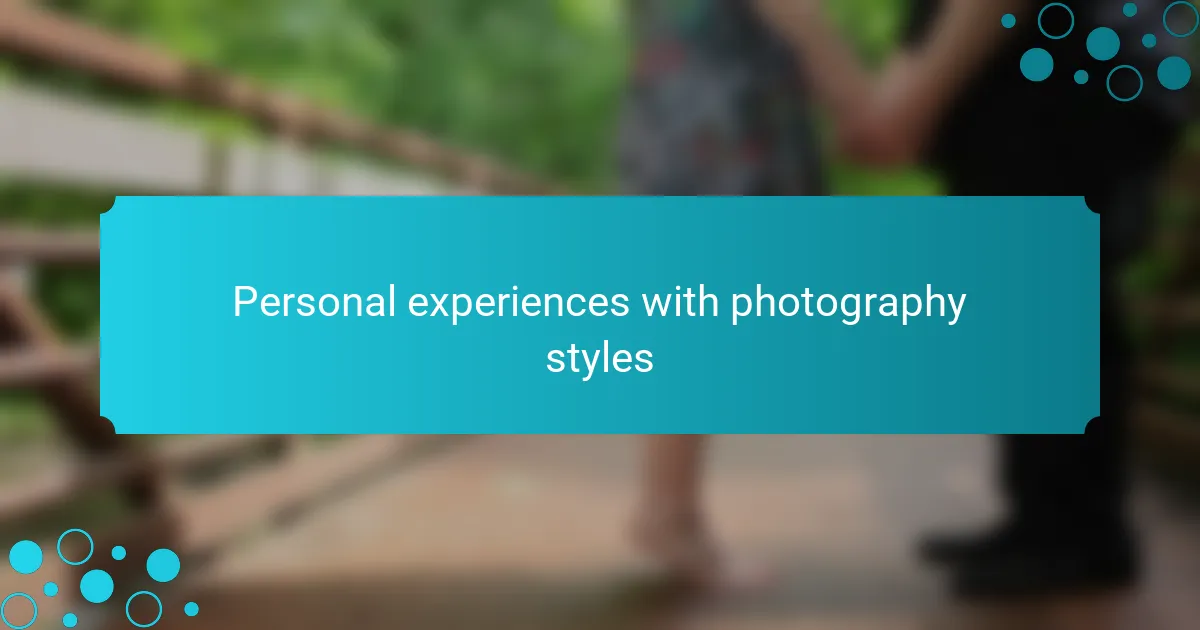
Personal experiences with photography styles
When I first started exploring different editorial photography styles, I felt a mix of excitement and nervousness. Each style brought forth a unique challenge that pushed my creativity. I remember one particular shoot that focused on high fashion—standing in a striking outfit against a vivid backdrop made me feel powerful and alive, igniting my passion for photography even more.
Over time, I’ve discovered that certain aspects of photography styles resonate deeply with me. It’s fascinating how the choice of lighting, color palettes, and angles can evoke different emotions and tell distinct stories. For example, the dreamy quality of fashion editorial photography allows for a sense of fantasy, while street style captures the raw energy of everyday life.
- Light and Shadow: Playing with these elements can transform an image, making it either dramatic or soft.
- Color Palettes: Bright colors can evoke joy, while muted tones tend to create a more somber, introspective mood.
- Angles and Composition: Experimenting with perspectives can lead to unexpected beauty and impact.
- Styling Choices: The outfits and props significantly influence the overall feel of a photograph, adding layers of meaning.
- Emotion in Poses: Capturing genuine expressions can connect the viewer to the image on a deeper level.
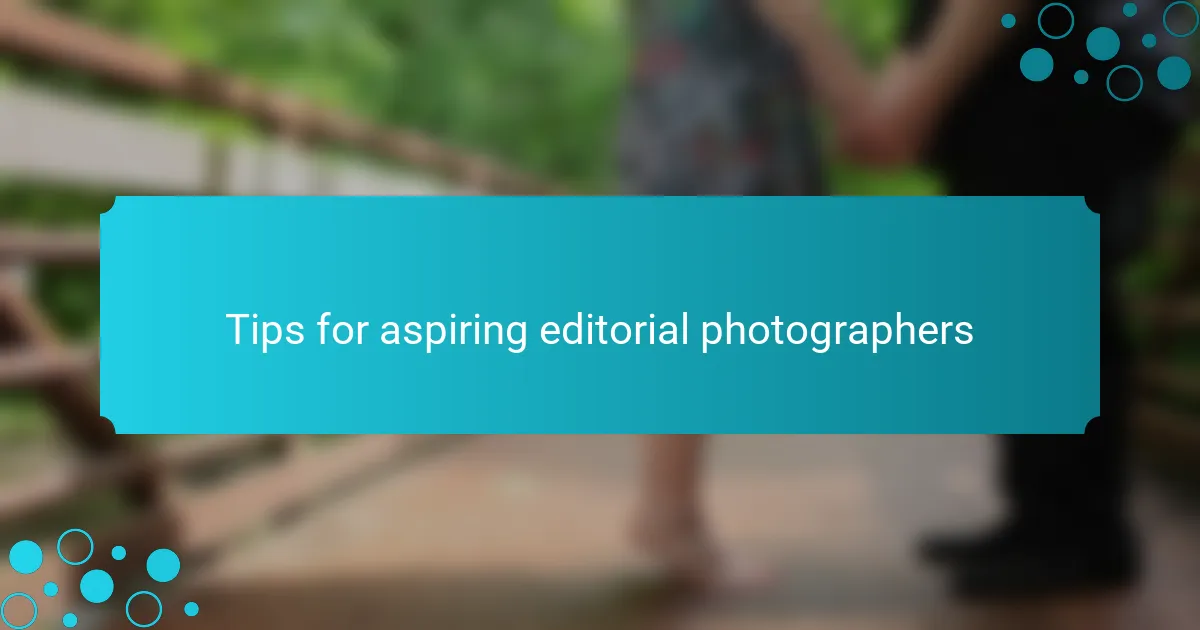
Tips for aspiring editorial photographers
When I think about tips for aspiring editorial photographers, one of the most important things I emphasize is finding a unique voice. It’s crucial to develop a signature style that resonates with your audience. During my early days, I experimented with various techniques and themes until I discovered what truly represented my artistic vision.
Another tip is to pay attention to trends but don’t let them dictate your work. It’s easy to get caught up in what’s popular, but I’ve always believed that authenticity shines through stronger than following the latest fad. I remember a time when I chose a more unconventional approach to a project, and it became one of my most praised works.
Lastly, network with other creatives. Collaborating and learning from others can offer fresh perspectives. I found that some of my best ideas came through discussions and brainstorming sessions with fellow photographers and stylists.
| Tip | Description |
|---|---|
| Develop a Signature Style | Focus on finding your unique voice that resonates with your audience. |
| Stay Authentic | Stay true to your vision instead of merely following trends. |
| Network | Engage with other creatives to gain fresh perspectives and ideas. |
